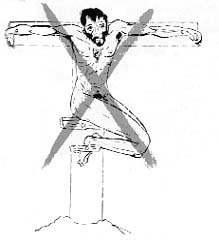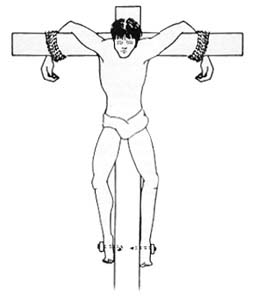Scholars’ Corner: New Analysis of the Crucified Man

In our January/February 1985 issue, we published an article about the only remains of a crucified man to be recovered from antiquity (“Crucifixion—The Archaeological Evidence,” BAR 11:01). Vassilios Tzaferis, the author of the article and the excavator of the crucified man, based much of his analysis of the victim’s position on the cross and other aspects of the method of crucifixion on the work of a medical team from Hebrew University-Hadassah Medical School headed by Nico Haas, who had analyzed the crucified man’s bones. In a recent article in the Israel Exploration Journal, however, Joseph Zias, an anthropologist with the Israel Department of Antiquities, and Eliezer Sekeles of Hebrew University-Hadassah Medical School in Jerusalem question many of Haas’s conclusions concerning the bones of the crucified man.a The questions Zias and Sekeles raise affect many of the conclusions about the man’s position during crucifixion.
According to Haas, the nail in the crucified man penetrated both his right and left heel bones, piercing the right heel bone (calcaneum) first, then the left. Haas found a fragment of bone attached to the right heel that he thought was part of the left heel bone (sustentaculum tali). If Haas’s analysis is correct, the two heel bones must have been penetrated by the same nail, and the victim’s legs must have been in a closed position on the cross.
But according to the new analysis of the bones just published in the Israel Exploration Journal, the bone fragment Haas identified as part of the left heel bone was incorrectly identified. “The shape and structure of this bony fragment is of a long bone; it cannot therefore be the left [heel bone],” say the most recent investigators. Their conclusions are confirmed by x-rays, which reveal the varying density, structure and direction of the bones.
Haas also incorrectly assumed that the nail is seven inches (17–18 cm) long. In fact, the total length of the nail from head to tip is only 4.5 inches (11.5 cm). A wooden plaque less than an inch thick (2 cm) had been punctured by the nail before it passed through the right heel bone. After exiting from the bone, the nail penetrated the cross itself and then bent, probably because it hit a knot. As the new investigators observe, given the length of the nail, “There simply was not enough room for both heel bones and a two centimeter wooden plaque to have been pierced by the nail and affixed to the vertical shaft of the cross. … The nail was sufficient for affixing only one heel bone to the cross.”
In short, only the right heel bone was penetrated—laterally, or sidewise—by the nail. Accordingly, the victim’s position on the cross must have been different from that portrayed by Haas.
The new investigators also dispute Haas’s conclusion that a scratch on the bone of the right forearm (radius) of the victim, just above the wrist, represents the penetration of a nail between the two bones of the forearm. According to Zias and Sekeles, such scratches and indentations are commonly found on ancient skeletal material, including on the right leg bone (fibula) of this man. Such scratches and indentations have nothing to do with crucifixion.
How then was the crucified man attached to the cross?
As the new investigators observe:
“The literary sources for the Roman period contain numerous descriptions of crucifixion but few exact details as to how the condemned were affixed to the cross. Unfortunately, the direct physical evidence here is also limited to one right calcaneum (heel bone) pierced by an 11.5 cm iron nail with traces of wood at both ends.”
According to the literary sources, those condemned to crucifixion never carried the complete cross, despite the common belief to the contrary and despite the many modern reenactments of Jesus’ walk to Golgotha. Instead, only the crossbar was carried, while the upright was set in a permanent place where it was used for subsequent executions. As the first-century Jewish historian Josephus noted, wood was so scarce in Jerusalem during the first century A.D. that the Romans were forced to travel ten miles from Jerusalem to secure timber for their siege machinery.
According to Zias and Sekeles:
“One can reasonably assume that the scarcity of wood may have been expressed in the economics of crucifixion in that the crossbar as well as the upright would be used repeatedly. Thus, the lack of traumatic injury to the forearm and metacarpals of the hand seems to suggest that the arms of the condemned were tied rather than nailed to the cross. There is ample literary and artistic evidence for the use of ropes rather than nails to secure the condemned to the cross.”
According to Zias and Sekeles, the victim’s legs straddled the vertical shaft of the cross, one leg on either side, with the nails penetrating the heel bones. The plaque or plate under the head of the nail, they say, was intended to secure the nail and prevent the condemned man from pulling his feet free.

As Haas correctly suggested, the nail probably hit a knot which bent the nail. However, as Zias and Sekeles reconstruct the removal of the dead man from the cross:
“Once the body was removed from the cross, albeit with some difficulty in removing the right leg, the condemned man’s family would now find it impossible to remove the bent nail without completely destroying the heel bone. This reluctance to inflict further damage to the heel led [to his burial with the nail still in his bone, and this in turn led] to the eventual discovery of the crucifixion.”
Whether the victim’s arms were tied, rather than nailed to the cross is irrelevant to the manner of his dying. As Zias and Sekeles point out:
“Death by crucifixion was the result of the manner in which the condemned man hung from the cross and not the traumatic injury caused by nailing. Hanging from the cross resulted in a painful process of asphyxiation, in which the two sets of muscles used for breathing, the intercostal [chest] muscles and the diaphragm, became progressively weakened. In time, the condemned man expired, due to the inability to continue breathing properly.”

